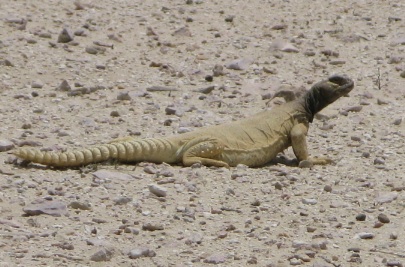Secrets of the Dhub
February, 2011

The dhub in its natural habitat.
Thanks to researchers, we now know a little more about an admired member of Qatar’s wildlife community.
Mostly unnoticed by city dwellers, spiny-tailed lizards, called “dhubs or dabs” in Arabic, are long-standing residents of Qatar. The large reptiles—males average about 1.5 kilos—live in burrows throughout the desert and are popular sights for nature lovers venturing out into the desert.
Except for the knowledge that they survive extreme temperatures, scarcity of water and lack of vegetation, details of dhub behavior have largely been a mystery. Scientists are beginning to uncover the facts about how they cope with such pressures and have possibly adapted to human development of their natural habitat.
“Until recently, the dhub was thought to be strictly herbivorous,” said Renee Richer, Ph.D., assistant
professor of biology at WCMC-Q and co-author of a study entitled “First evidence of scavenging behavior in the herbivorous lizard Uromastyx aegyptia microlepis,” in press at the Journal of Arid Environments.
The study showed that the animal is actually a scavenger, known to eat meat and insects in times of scarce vegetation.
Aurora Castilla, a biologist at the Forest Technology Center of Catalonia in Solsona, Spain, and the National Museum of Natural Science in Madrid, Spain, led the study in collaboration with Richer; Anthony Herrel, of the Museum of Natural History in Paris; April Ann Torres Conkey, of Carnegie Melon University in Qatar; John Tribuna, of Qatar University; and Mohamed al-Thani, a second-year medical student at WCMC-Q.
The study involved examining hundreds of samples of dhub feces, which not only told the story of what they ate but also of how extremely variable their food choices became.
“There were times of year when we were finding nothing but small bits of grass and twigs—they were surviving on the most meager scraps that they could find,” Richer said. “But then we found one sample that had a minimum of 19 species in it. So when times are good, the dhub is out there eating.”
Richer says that these findings may also show the dhub’s reliance on dead carcasses along the road, which weaves human development firmly into the web of study for biologists—one species’ tragedy along a man-made road becomes another’s banquet.
“The relationship between the dhub and humans is complex and that is something we’d really like to understand better,” Richer said. “Is human development having a negative impact or are we in fact somehow inadvertently aiding the population?”
Richer is working now with collaborators to secure resources for population and continued behavioral studies of the dhub.
By Emily Alp
